Ang indi makahibalo magbalikid sa iya nga ginhalinan, indi makalab-ot sa iya padulungan. Some refer to it as the national proverb and yet few Filipinos ever put it to heart. That's the Hiligaynon translation. The moment I got off the tricycle in front of our house in Bacolod, I knew I was home.It was refreshing seeing a familiar place although I've been there only thrice in my life and not in the past ten years. As I opened the gate, I felt a surge of energy. Walking around brought back memories more so as I looked at a photo of myself as a kid on the walls of one of the rooms. My grandparents died a few months apart in September 2002 and February 2003. I never got to attend their wakes since for some reason, I was out of the country when it happened. It's a coincidence that they died a few months apart since they were born just two months apart as well.Tired from the non-stop travel, I went straight to bed.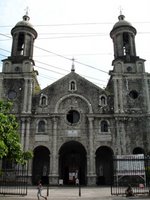 I woke up the next day to catch the ferry to Iloilo City. I had wanted to see Iloilo for the longest time and now that I was in Bacolod, this was my chance. But before that, I walked to the Cathedral of Bacolod which was on the same street as our house, to take photos.Bacolod is called the City of Smiles. Just like the City of San Fernando in Pampanga, Bacolod City is the capital of a rich sugar-producing province, Negros Occidental. It's also a coincidence that both my mom and my dad are from sugar-producing provinces.
I woke up the next day to catch the ferry to Iloilo City. I had wanted to see Iloilo for the longest time and now that I was in Bacolod, this was my chance. But before that, I walked to the Cathedral of Bacolod which was on the same street as our house, to take photos.Bacolod is called the City of Smiles. Just like the City of San Fernando in Pampanga, Bacolod City is the capital of a rich sugar-producing province, Negros Occidental. It's also a coincidence that both my mom and my dad are from sugar-producing provinces. According to oral tradition, the Henares clan were weavers from Iloilo. During the middle of the 19th Century, there was an exodus of migrants from Iloilo to the sparsely-populated island of Negros due to a boom in sugar production. Having been orphaned, the siblings led by Mateo, my great-great grandfather, and his brother Esteban, joined the migration to Negros and upon arriving, armed only with the knowledge of the Spanish language, secured a loan that would serve as capital for what would become a plantation in Talisay.
According to oral tradition, the Henares clan were weavers from Iloilo. During the middle of the 19th Century, there was an exodus of migrants from Iloilo to the sparsely-populated island of Negros due to a boom in sugar production. Having been orphaned, the siblings led by Mateo, my great-great grandfather, and his brother Esteban, joined the migration to Negros and upon arriving, armed only with the knowledge of the Spanish language, secured a loan that would serve as capital for what would become a plantation in Talisay. To make the long story short, the venture boomed. Mateo managed the plantation in Talisay while Esteban took care of business in Bacolod. The brothers were able to build their homes in an area along what is now Rizal Street. This area during the early post-war years was fondly referred to as Henares block since everyone in the block was a Henares. As a result of this hardwork, they were able to send their children to the best schools in Manila, among whom were my great-grandfather Pedro G. Henares (UP College of Medicine, 1915; Bacolod's first health officer, 1917 to 1919; and municipal councilor, 1925 to 1928), and his younger brother Hilarion G. Henares, Sr. (UP College of Engineering, 1917; and a government pensionado), the father of journalist and former cabinet secretary Larry Henares. Esteban Henares even became municipal president (mayor) of Bacolod from 1913 to 1916. Well, that's a little bit of family history and I'll stop here lest I bore you. Hehe!From the cathedral, I took a pedicab to the pier since it was in the reclamation area, quite far for a walk and since no jeeps passed that area. There were a lot of fast ferries available and I picked the one that would bring me there the fastest. Hehe! The student fare on Ocean Jet is PHP221 one-way. Hmmm, I didn't expect it to cost that much for such a short trip. Well, you get what you pay for. The seats were in good condition and they get you there in exactly an hour.
To make the long story short, the venture boomed. Mateo managed the plantation in Talisay while Esteban took care of business in Bacolod. The brothers were able to build their homes in an area along what is now Rizal Street. This area during the early post-war years was fondly referred to as Henares block since everyone in the block was a Henares. As a result of this hardwork, they were able to send their children to the best schools in Manila, among whom were my great-grandfather Pedro G. Henares (UP College of Medicine, 1915; Bacolod's first health officer, 1917 to 1919; and municipal councilor, 1925 to 1928), and his younger brother Hilarion G. Henares, Sr. (UP College of Engineering, 1917; and a government pensionado), the father of journalist and former cabinet secretary Larry Henares. Esteban Henares even became municipal president (mayor) of Bacolod from 1913 to 1916. Well, that's a little bit of family history and I'll stop here lest I bore you. Hehe!From the cathedral, I took a pedicab to the pier since it was in the reclamation area, quite far for a walk and since no jeeps passed that area. There were a lot of fast ferries available and I picked the one that would bring me there the fastest. Hehe! The student fare on Ocean Jet is PHP221 one-way. Hmmm, I didn't expect it to cost that much for such a short trip. Well, you get what you pay for. The seats were in good condition and they get you there in exactly an hour.
 I finally stepped foot in the City of Gentle People. It was said that Dr. Jose P. Rizal himself created this nickname for Dumaguete City during his brief stopover in the town on August 1, 1896 en route to Dapitan. I arrived in Dumaguete at 4 p.m. after a quick trip via fast craft from Siquijor. Right by the port were the famous buildings of Silliman University. After taking a few photos, my SSEAYP batchmate Tere Sicat arrived at the port and took me around town. We first went to the neighbring town of Bacong where another national cultural treasure could be found, the San Agustin Church.
I finally stepped foot in the City of Gentle People. It was said that Dr. Jose P. Rizal himself created this nickname for Dumaguete City during his brief stopover in the town on August 1, 1896 en route to Dapitan. I arrived in Dumaguete at 4 p.m. after a quick trip via fast craft from Siquijor. Right by the port were the famous buildings of Silliman University. After taking a few photos, my SSEAYP batchmate Tere Sicat arrived at the port and took me around town. We first went to the neighbring town of Bacong where another national cultural treasure could be found, the San Agustin Church.
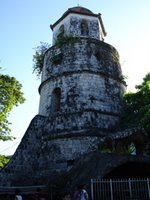 It was about thirty minutes south of Dumaguete. On the way to Bacong, we passed by the Dumaguete belltower and several Gabldon schoolbuildings to take photos. When we got there, the first thing I noticed was the charming presidencia in front of a wide lawn, typical of many Negros towns and cities.
It was about thirty minutes south of Dumaguete. On the way to Bacong, we passed by the Dumaguete belltower and several Gabldon schoolbuildings to take photos. When we got there, the first thing I noticed was the charming presidencia in front of a wide lawn, typical of many Negros towns and cities.
 It was quite a while before we got in the church since we had to look for the key. But when we entered, I thought it was not that much impressive for a national cultural treasure. It had an old pipe organ and well-preserved retablos but that was it. I wonder how this church got chosen for the list of 26 but nevertheless, that was fine with me. But just to clarify, there are more than 26 national cultural treasures. Others got declared during the time of Marcos.
It was quite a while before we got in the church since we had to look for the key. But when we entered, I thought it was not that much impressive for a national cultural treasure. It had an old pipe organ and well-preserved retablos but that was it. I wonder how this church got chosen for the list of 26 but nevertheless, that was fine with me. But just to clarify, there are more than 26 national cultural treasures. Others got declared during the time of Marcos.
 After Bacong, we went back to Dumaguete to stroll down the "boulevard" along the sea. You've never been to Dumaguete if you haven't strolled down the promenade beside Rizal Boulevard. It was a great view since to your left, you could see the island of Cebu, while Siquijor was to your right. It just shows how close the islands of the Visayas are to each other. It's funny though how sand along the Negros coastline was mostly gray when it's neighbors had a lot of white sand.
After Bacong, we went back to Dumaguete to stroll down the "boulevard" along the sea. You've never been to Dumaguete if you haven't strolled down the promenade beside Rizal Boulevard. It was a great view since to your left, you could see the island of Cebu, while Siquijor was to your right. It just shows how close the islands of the Visayas are to each other. It's funny though how sand along the Negros coastline was mostly gray when it's neighbors had a lot of white sand.
 I really liked the lamp posts. It was good that they were able to preserve them. Along the road, you could see nice pre-war homes and even a hotel that was restored to its original grandeur.
I really liked the lamp posts. It was good that they were able to preserve them. Along the road, you could see nice pre-war homes and even a hotel that was restored to its original grandeur.
Another must do in Dumagute is a visit to the tempurahan at the end of the boulevard. Again, it's another you-haven't-been-to- Dumaguete kind of thing which one should include in a trip.
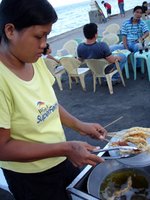 It may be called tempura because it is shaped like the Japanese fried shrimp dish. But it tasted more like kikiam to me. You had neatly arranged carts, seats and tables lined up in clean rows and columns. Each was sold for PHP3 a piece. They also had squidballs as well as balut and penoy for sale. I really look for these places everytime I travel thanks to my friends in Singapore and Malaysia who went out of their way to let me have a taste of the best hawker food when I was there.
It may be called tempura because it is shaped like the Japanese fried shrimp dish. But it tasted more like kikiam to me. You had neatly arranged carts, seats and tables lined up in clean rows and columns. Each was sold for PHP3 a piece. They also had squidballs as well as balut and penoy for sale. I really look for these places everytime I travel thanks to my friends in Singapore and Malaysia who went out of their way to let me have a taste of the best hawker food when I was there.
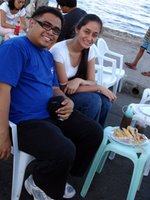
 They told me that when they came to the Philippines, they also wanted to eat hawker food which didn't get a good response from me obviously since I didn't want to bring any of my guests to the hospital. Haha! At the moment, the only safe place for hawker food I know in Manila is UP Diliman. For some reason, I feel it's safer eating hawker food in the provinces. After that tasty snack, it was off to Teresa's house for dinner.
They told me that when they came to the Philippines, they also wanted to eat hawker food which didn't get a good response from me obviously since I didn't want to bring any of my guests to the hospital. Haha! At the moment, the only safe place for hawker food I know in Manila is UP Diliman. For some reason, I feel it's safer eating hawker food in the provinces. After that tasty snack, it was off to Teresa's house for dinner.
They prepared a lot of food. Really great! We didn't have much time to chat since I was after the last bus to Bacolod which left at 7:30 p.m. It was midnight again when I arrived in my dad's hometown.
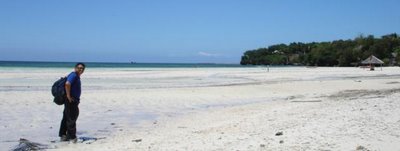 I took the M.V. Don Martin from Tagbilaran to Larena in Siquijor. People told me that the ship left the port at 10 p.m. But by 8:30 p.m, my traveller's instincts were telling me to go. And I got there in the nick of time since the ship was scheduled to leave at 8:45 p.m.! Everything has been so photo finish for me when it came to ship departures. Hehe! Lesson number one, always ask schedules from people at the pier. They know best! Hehe!
I took the M.V. Don Martin from Tagbilaran to Larena in Siquijor. People told me that the ship left the port at 10 p.m. But by 8:30 p.m, my traveller's instincts were telling me to go. And I got there in the nick of time since the ship was scheduled to leave at 8:45 p.m.! Everything has been so photo finish for me when it came to ship departures. Hehe! Lesson number one, always ask schedules from people at the pier. They know best! Hehe! The trip took a little over three hours and costed PHP246.40. On the way, friends were warning me about the island and teaching me ways to counteract the spells of the magbabarang or mangkukulam (black witches), that I should find the nearest lodge available and close all the windows, etc. Thanks! That wasn't any help since I was arriving at 12 midnight! Hehe!Mysticism in Siquijor becomes most active on Black Saturday. In the belief that with the death of Jesus Christ, creatures not of this realm roam the earth and share their healing powers, albularyos or mananambal (witch doctors) converge in the barangay of San Antonio in Siquijor to prepare healing potions. Using ancient incantations, they throw into a big cauldron a mixture of coconut oil, herbs, tree bark, roots, insects, dirt and other secret ingredients to create a potent brew that is said to cure various ailments.
The trip took a little over three hours and costed PHP246.40. On the way, friends were warning me about the island and teaching me ways to counteract the spells of the magbabarang or mangkukulam (black witches), that I should find the nearest lodge available and close all the windows, etc. Thanks! That wasn't any help since I was arriving at 12 midnight! Hehe!Mysticism in Siquijor becomes most active on Black Saturday. In the belief that with the death of Jesus Christ, creatures not of this realm roam the earth and share their healing powers, albularyos or mananambal (witch doctors) converge in the barangay of San Antonio in Siquijor to prepare healing potions. Using ancient incantations, they throw into a big cauldron a mixture of coconut oil, herbs, tree bark, roots, insects, dirt and other secret ingredients to create a potent brew that is said to cure various ailments. Anyway, I arrived in Larena in one piece. Hehe! At the port, I immediately asked for the schedules to Dumaguete and the nearest lodge. It turns out, the nearest lodge was a few meters from the port. Thank God! The trips to Dumagute left from the neighboring town of Siquijor which is the provincial capital. I had wanted to leave by lunch but they had a 10 a.m. and a 3 p.m. departure closest to lunch so I didn't have any choice.The lodge was very basic. A room, bed and electric fan all for the price of PHP150. Good enough for a few hours of sleep. I woke up at 6 a.m. and got ready for the trip around the island. But first, I stopped by the bell tower of Larena in the town proper which was a short walk up. The lodge owner told me that they used to have an old church just like the rest of the towns, but it was demolished by some priest and replaced with a new one. Just great! At least the bell tower was still there.
Anyway, I arrived in Larena in one piece. Hehe! At the port, I immediately asked for the schedules to Dumaguete and the nearest lodge. It turns out, the nearest lodge was a few meters from the port. Thank God! The trips to Dumagute left from the neighboring town of Siquijor which is the provincial capital. I had wanted to leave by lunch but they had a 10 a.m. and a 3 p.m. departure closest to lunch so I didn't have any choice.The lodge was very basic. A room, bed and electric fan all for the price of PHP150. Good enough for a few hours of sleep. I woke up at 6 a.m. and got ready for the trip around the island. But first, I stopped by the bell tower of Larena in the town proper which was a short walk up. The lodge owner told me that they used to have an old church just like the rest of the towns, but it was demolished by some priest and replaced with a new one. Just great! At least the bell tower was still there.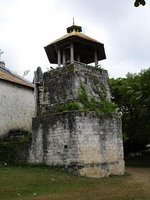 From Larena, I took a jeep to Lazi. The Church of San Isidro Labrador is a national cultural treasure. Anyway, what I expected to be an hour took close to three hours! Jeeps in Siquijor drive extremely slow and I mean an average of 20 to 30 kph! And we stopped here and there to pick up passengers and load stuff on board. So instead of catching the 10 a.m., I had no choice but to take the 3 p.m.On the way to Lazi was Maria where another bell tower and church stood. While the jeep was waiting for passengers at the market, I took some photos of the bell tower. The Church of the Nuestra Senora de Providencia was still intact. Good! After a few minutes, we were off to Lazi. Finally, after a long and slow trip, I was in front of the church.
From Larena, I took a jeep to Lazi. The Church of San Isidro Labrador is a national cultural treasure. Anyway, what I expected to be an hour took close to three hours! Jeeps in Siquijor drive extremely slow and I mean an average of 20 to 30 kph! And we stopped here and there to pick up passengers and load stuff on board. So instead of catching the 10 a.m., I had no choice but to take the 3 p.m.On the way to Lazi was Maria where another bell tower and church stood. While the jeep was waiting for passengers at the market, I took some photos of the bell tower. The Church of the Nuestra Senora de Providencia was still intact. Good! After a few minutes, we were off to Lazi. Finally, after a long and slow trip, I was in front of the church.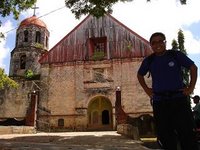
 The convent in front of the church is said to be the biggest in Asia. Sigh! I wished that we had this grand architecture in the Philippines today. The last great builder was none other than former First Lady Imelda Marcos whose edifice complex envisioned the Cultural Center of the Philippines and its adjacent buildings done ny national artist Leandro Locsin. But everything today is stunted by our tingi culture. Many, if not most Filipinos have small dreams. It is time to make this country great again by encouraging young people to think big!
The convent in front of the church is said to be the biggest in Asia. Sigh! I wished that we had this grand architecture in the Philippines today. The last great builder was none other than former First Lady Imelda Marcos whose edifice complex envisioned the Cultural Center of the Philippines and its adjacent buildings done ny national artist Leandro Locsin. But everything today is stunted by our tingi culture. Many, if not most Filipinos have small dreams. It is time to make this country great again by encouraging young people to think big! I had wanted to go to nearby Cambugahay Falls. I tried looking for a habal-habal (motorcycle taxi) to take me there but then given the time it may take to get to Siquijor, I decided to forego the trip and go straight to Siquijor. It was another slow trip to Siquijor. It was so slow, I thought I might even miss the 3 p.m.!
I had wanted to go to nearby Cambugahay Falls. I tried looking for a habal-habal (motorcycle taxi) to take me there but then given the time it may take to get to Siquijor, I decided to forego the trip and go straight to Siquijor. It was another slow trip to Siquijor. It was so slow, I thought I might even miss the 3 p.m.!
When I got to Siquijor, I went straight to the Church of St. Francis of Assisi. In front of the church was another fortress convent. Impressive! Like most convents, it was being used as the parish school of Siquijor. While waiting for the ship to arrive, I trekked to the nearby beach to check it out. Photos are at the top. Although the better beaches are a few minutes away.
While waiting for the ship to arrive, I trekked to the nearby beach to check it out. Photos are at the top. Although the better beaches are a few minutes away.
Then I had lunch at this lodge beside the port. At least it was a real meal. Hehe! I had survived on crackers and other snacks the whole day. The Delta fast ferry for Dumaguete left at 3 p.m.
 I woke up the next day to catch the ferry to Iloilo City. I had wanted to see Iloilo for the longest time and now that I was in Bacolod, this was my chance. But before that, I walked to the Cathedral of Bacolod which was on the same street as our house, to take photos.
I woke up the next day to catch the ferry to Iloilo City. I had wanted to see Iloilo for the longest time and now that I was in Bacolod, this was my chance. But before that, I walked to the Cathedral of Bacolod which was on the same street as our house, to take photos. According to oral tradition, the Henares clan were weavers from Iloilo. During the middle of the 19th Century, there was an exodus of migrants from Iloilo to the sparsely-populated island of Negros due to a boom in sugar production. Having been orphaned, the siblings led by Mateo, my great-great grandfather, and his brother Esteban, joined the migration to Negros and upon arriving, armed only with the knowledge of the Spanish language, secured a loan that would serve as capital for what would become a plantation in Talisay.
According to oral tradition, the Henares clan were weavers from Iloilo. During the middle of the 19th Century, there was an exodus of migrants from Iloilo to the sparsely-populated island of Negros due to a boom in sugar production. Having been orphaned, the siblings led by Mateo, my great-great grandfather, and his brother Esteban, joined the migration to Negros and upon arriving, armed only with the knowledge of the Spanish language, secured a loan that would serve as capital for what would become a plantation in Talisay. To make the long story short, the venture boomed. Mateo managed the plantation in Talisay while Esteban took care of business in Bacolod. The brothers were able to build their homes in an area along what is now Rizal Street. This area during the early post-war years was fondly referred to as Henares block since everyone in the block was a Henares. As a result of this hardwork, they were able to send their children to the best schools in Manila, among whom were my great-grandfather Pedro G. Henares (UP College of Medicine, 1915; Bacolod's first health officer, 1917 to 1919; and municipal councilor, 1925 to 1928), and his younger brother Hilarion G. Henares, Sr. (UP College of Engineering, 1917; and a government pensionado), the father of journalist and former cabinet secretary Larry Henares. Esteban Henares even became municipal president (mayor) of Bacolod from 1913 to 1916. Well, that's a little bit of family history and I'll stop here lest I bore you. Hehe!
To make the long story short, the venture boomed. Mateo managed the plantation in Talisay while Esteban took care of business in Bacolod. The brothers were able to build their homes in an area along what is now Rizal Street. This area during the early post-war years was fondly referred to as Henares block since everyone in the block was a Henares. As a result of this hardwork, they were able to send their children to the best schools in Manila, among whom were my great-grandfather Pedro G. Henares (UP College of Medicine, 1915; Bacolod's first health officer, 1917 to 1919; and municipal councilor, 1925 to 1928), and his younger brother Hilarion G. Henares, Sr. (UP College of Engineering, 1917; and a government pensionado), the father of journalist and former cabinet secretary Larry Henares. Esteban Henares even became municipal president (mayor) of Bacolod from 1913 to 1916. Well, that's a little bit of family history and I'll stop here lest I bore you. Hehe!















